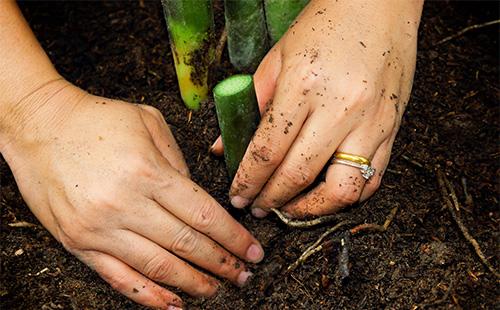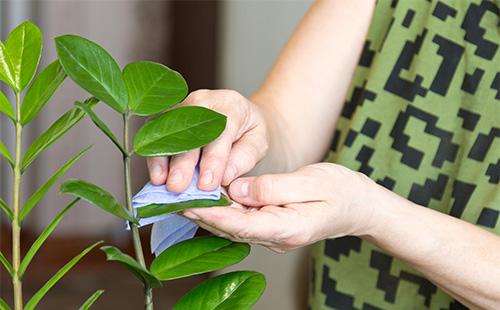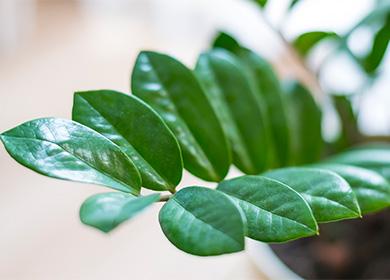The content of the article
Kenya is considered to be the birthplace of Zamioculcas (dollar tree). The climate there is complicated - heavy tropical rains give way to long periods of drought. Due to the specific climate, the plant has learned to accumulate moisture in tubers, roots and leaves.
Description and Features
The structure of the plant was affected by the peculiarities of the changing climate of the tropics. Zamioculcas in nature grows on stony soil - even in the season of heavy rains, moisture is not stored in it. Therefore, the plant accumulates water and during a drought lives due to this moisture. Complex leaves have an interesting structure. They consist of a fleshy axis with leathery leaves pairwise attached to it. The number of leaves on one axis reaches 12 pieces. At the very bottom of the axis there is a thickening. In an apartment, the sheet height rarely exceeds 60 cm, but in good conditions it can grow up to one and a half meters.
It grows slowly - grows no more than two leaves per year. The color is very saturated - the leaves are dark green with a pronounced gloss. With prolonged drought, it discards leaves to retain enough moisture in the rhizome. With the resumption of watering, the leaves grow back. The stem may be above ground or underground. It is transformed into a tuber, from which thick roots and leaves grow. The glossy wax coating on the leaves prevents excess evaporation and reflects the hot rays of the sun.
If zamioculcas does not bloom, do not be surprised at this and try to stimulate flowering. Only adult plants bloom and very rarely. In nature, flowers bloom at the base of the leaves. The inflorescence is a light cob wrapped in a small blanket. The flowers are small and inconspicuous. Flower growers usually simply cut the peduncle at the initial stage of its appearance, so as not to weaken the plant. In addition to this peculiarity of care for Zamioculcus during flowering, it is advisable to carry out extra feeding. The plant spends a lot of nutrients on the formation of inflorescences.
What to do immediately after purchase
How to care for zamioculcas after purchase? Two to three weeks will be spent on the adaptation period. The flower is placed separately from other plants, treated with weak solutions of fungicide and insecticide, protected from the sun, drafts and other adverse factors. Watering is moderate, fertilizers do not make.
After successful adaptation, Zamioculcas can be transplanted into another pot. A wide pot is selected so that there are no problems with transplantation in the future. After transplantation, top dressing is not done for three weeks.
Nuances of care for Zamioculcus
The care is basic, accessible even to beginner growers. The plant is not moody. Due to its natural features, it is easily put up with temporary drought and heat. But zamioculcas reaches maximum decorativeness only with proper care.
- Lighting. The plant is large in size - you can only keep it on the windowsill in the first years of life. Most often grown in a tub on the floor. They are placed closer to the window so that the plant receives diffused sunlight at least six hours a day.
- Temperature. Heat-loving culture. It treats heat normally, and suffers from severe cooling. Even in winter, the air temperature should not fall below 16 ° C. The average room temperature fully satisfies the needs of zamioculcas in heat.
- Watering. Watering should be plentiful, but rare. In between watering, wait until the soil is almost completely dry. Due to its ability to accumulate moisture with excess fluid, the tuber rots.
- Humidity. Normally refers to dry air, but with high humidity it looks better. In the winter and summer in the heat, regular spraying is mandatory.
- The soil. A universal soil mixture or substrate for cacti is quite suitable. Houses make a mixture of leafy land, turf, peat and sand. All components are taken in equal proportions. Sometimes crushed sphagnum is added.
- Top dressing. Use fertilizer for succulent plants. The most common option is Agricola. It is allowed to feed no more than once every three weeks. Take a half dose, feed the day after watering. From mid-autumn to early spring fertilizers are not applied.
- Transfer. Until the age of three, Zamioculcas is transplanted annually, until the age of six - once every two years. Adult large specimens can not be transplanted up to five years. But once a year it is advisable to replace the topsoil.
Breeding methods
Zamioculcas can be propagated at home in two ways - cuttings and tubers. The plant is difficult to reproduce, poorly and very slowly rooted. Stimulators of growth and root formation help accelerate the process.
Cuttings
Zamioculcas can be rooted in a stem, leaf, or even part of a leaf. The process is long, but often gives good results. Suitable even for the propagation of young plants. Root in the following order.
- Pieces of the stem, sheets or parts of the sheets are dipped in a solution of the drug to stimulate the formation of roots. Use "Heteroauxin" or "Kornevin."
- A sterile soil consisting of sand and peat is prepared. You can use just sand previously calcined in the oven.
- The substrate is poured into a flat, wide container, moistened from a spray bottle, and cuttings are planted.
- Cuttings are covered with plastic cups. Keep warm, in good light, periodically sprayed from the spray gun and ventilate.
Growing zamioculcas from a leaf is a lengthy process. Depending on the temperature, humidity and characteristics of the mother plant, the rooting process can take from one month to six months.

Tuber division
This four-step method is suitable for propagating adult, fully formed plants. Young specimens may not tolerate procedures. The larger the tuber, the greater the likelihood of success.
- The plant is removed from the ground, the tuber is cleaned of residual substrate.
- A tuber with a sharp knife is cut into several parts, leaving at least one growth point on each dividend.
- Slices are sprinkled with carbon powder. According to some gardeners, ground cinnamon has a good disinfecting, drying effect.
- Delenki planted in pre-prepared pots filled with sterile peat-sand soil. The tuber head is not deeply buried. They put in a warm, bright place.
The first time you need to water the delenki carefully - when waterlogging in the places of cuts, rot forms. Delenki grow very slowly - they need time to build up the root system.
Common growing problems
Despite the unpretentiousness of zamioculcas, difficulties in its cultivation nevertheless arise. They are mainly associated with improper care - irregular or excessive watering, inappropriate location. Most problems are resolved simply by adjusting care. The most common problems and solutions can be found in the table.
Table - Problems in growing Zamioculcas
| Problem | The reasons | What to do |
|---|---|---|
| Zamioculcas leaves turn yellow | - Systematic waterlogging of the soil; - cold; - prolonged drought; - plentiful top dressing | - Adjust care regimen |
| Leaves turn pale | - lack of light | - Put closer to the window; - organize additional lighting |
| Wrinkled stems | - Rare watering, depletion of moisture reserves; - damage to the roots (there is nothing to absorb water) | - Normalize the watering regime; - check the condition of the roots, if necessary, transplant |
| Leaves fall | - Lower - age pattern; - young - pests, lack of moisture, damage to the roots | - Inspect zamioculcas for pests; - regulate the care regimen; - inspect the root system |
| Dark spots appeared | - Excessive watering; - low temperature | - Reduce watering; - change the soil; - put in a warm place |
| Zamioculcas dries up | - pests; - rotten roots; - prolonged lack of watering | - Inspect for pests; - check the root system; - adjust the care regimen |
| Zamioculcas does not bloom | - Very rarely blooms in apartments | - Artificially stimulate flowering is not necessary |

Common diseases and pests
Diseases are a fairly rare occurrence for Zamioculcas. The main problem is rot of the root system, rhizome. The reasons are different - fungus, damp soil, cold, dense soil. Rot treatment - cutting out all decayed areas, processing with coal powder, drying the tubers to form a dense crust. Treated plants are planted in a light sterile soil, kept at minimal watering.
Pests are more common. Aphids give gardeners the most trouble whitefly, scabbard and spider mite. How to recognize pests and get rid of them? All this information is described in the table.
Table - Zamioculcus pests
| Insect | How to detect | How to get rid |
|---|---|---|
| Aphid | - Transparent sticky coating; - twisting young shoots | - Wash zamioculcas with soap; - spray with tobacco dust infusion |
| Whitefly | - Little white midges; - sticky coating; - drying and falling of leaves | - Hang sticky tapes for flies; - spray the plant with an insecticide |
| Spider mite | - Light points; - yellowing, deformation of the leaves - spider web on the inside of the leaves | - Increase humidity; - spray the plant with oil; - spray more often with water; - treated with the drug "Aktara" |
| Shield | - Golden brown plaques on stems, leaves and petioles; - sticky drops; - wilting plants | - Remove insects with an old toothbrush; - wipe the lesion with alcohol; - spray with any insecticide |
Since it is not very difficult to care for Zamioculcus, it can often be found in offices. Zamioculcas looks no less impressive in spacious living rooms. The main advantages of the plant are the absence of a pronounced period of rest, high decorativeness throughout the year.

